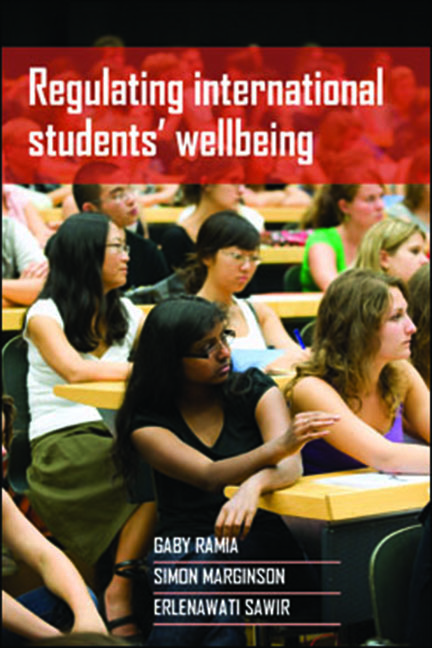Book contents
- Frontmatter
- Contents
- List of figures and tables
- Acknowledgements
- Preface
- one Introduction: global students and their discontents
- two Governing globalisation? National regulation and international student wellbeing
- three Fast growing, diverse: mapping the business of international education
- four ‘There’s gold in them thar students!’ Australia and New Zealand in the global market
- five Much regulation, minimal protection: the Australian model
- six Pastoral care, minimal information: the New Zealand model
- seven Different frameworks, similar outcomes: comparing Australia and New Zealand
- eight Doing it differently: national and global re-regulation and trans-national student citizens
- nine Conclusion
- References
- Index
five - Much regulation, minimal protection: the Australian model
Published online by Cambridge University Press: 03 February 2022
- Frontmatter
- Contents
- List of figures and tables
- Acknowledgements
- Preface
- one Introduction: global students and their discontents
- two Governing globalisation? National regulation and international student wellbeing
- three Fast growing, diverse: mapping the business of international education
- four ‘There’s gold in them thar students!’ Australia and New Zealand in the global market
- five Much regulation, minimal protection: the Australian model
- six Pastoral care, minimal information: the New Zealand model
- seven Different frameworks, similar outcomes: comparing Australia and New Zealand
- eight Doing it differently: national and global re-regulation and trans-national student citizens
- nine Conclusion
- References
- Index
Summary
Introduction
The Australian model of international student welfare regulation has more formal provisions than almost all others. It has a more extensive body of legislation dealing directly with international higher education than comparable Anglo common law countries, such as the UK and the US, and it has an accompanying set of regulations guiding educational providers. Australia is a signatory to GATS, thus bearing (albeit loose) connections to international instruments. There are also extensive rules on migration through education, which continue to evolve to the time of writing, conventions governing the provision of trans-national education, quality assurance mechanisms and individual legal provisions operating at the local level. The Australian government has also introduced an independent arbiter specific to international education to hear student grievances unresolved at institution level – in legal expression, an ombudsman existing within and as a branch of the Commonwealth ombudsman that handles complaints by vocational college students. Finally, Australia has legislation and accompanying formal regulations specifically applied to higher and vocational education together, incorporating student consumer protection and limited pastoral care rights provisions. These take the form of the ESOS Act and the National Code, together commonly referred to as the ‘ESOS Framework’.
The objective of this chapter is to interrogate the Australian regulation regime, examining the formal mechanisms using existing literature and key documents, and primary data from students whose home countries are from all over the world, although in the great majority of cases from Asia. The students whose views are discussed in data analysis are enrolled in nine Australian universities and represent a range of regions and sub-sectors across the country. However, interviews with staff from universities and the relevant national policy portfolios provide the basis for the more extensive analysis, supplementing the student data by uncovering the rationales behind, and the gaps within, the formal regulation sphere. This approach allows for the induction of insights into the informal sphere, which, we argue, is the more deterministic despite the extensive formal provisions.
Analysis of the interview data leads directly to the central finding of the chapter, that despite the extensive codification underpinning the ESOS Framework, the regulation of international student welfare is largely non-specific and mainly non-binding in effect.
- Type
- Chapter
- Information
- Regulating International Students’ Wellbeing , pp. 77 - 98Publisher: Bristol University PressPrint publication year: 2013

